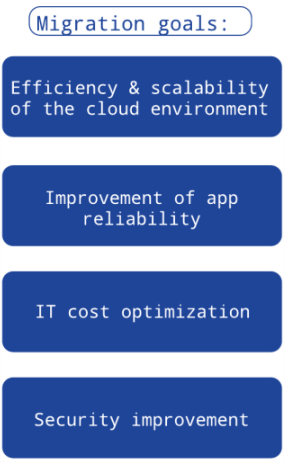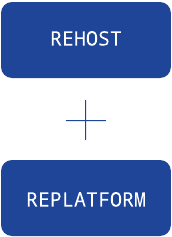Cloud migration as a strategic investment in the company's future
Learn how we helped an online gambling leader increase profits by migrating several data centers with 700+ applications to AWS.
Opportunity Spread across multiple data centers
A well-planned and successful migration to the cloud allows companies to make huge savings. Therefore moving to the cloud should not be perceived as an expense, but an investment to deliver company profits in the short and long term.
In 2019, a leading gambling company — operating in 10 countries and employing over 12,000 workers — decided to migrate its resources to AWS. The challenge was all the greater as there was a need to transfer many of the 700 applications in different sizes.
The existing applications are both single services on containers and monoliths built on virtual machines, which increases complexity — with the entire customer infrastructure located in several traditional data centers.
Amazon Web Services, a market-leading provider of cloud services, was selected to carry out the process, and several executive partners, including Chaos Gears, were selected to carry out the migration process.
Cloud migration as a chance to scale up
The main reason for the decision to migrate to the cloud was the need for the business to scale up its operations. A growing number of users meant that the outdated infrastructure no longer met the needs of the client, hampering development plans.
It was necessary to rapidly introduce a solution that would improve development of operations, and allow for failure-free handling of growing traffic and process optimization. The decision to move to the cloud would translate in a reduction in costs compared to the use of traditional infrastructure while increasing the company's competitiveness.

Planning as the key to a successful migration
Due to the scale of the migration, the company decided to use the largest provider of cloud solutions. Therefore AWS engineers also participated in the planning process. As the first step to migration, teams of AWS Professional Services specialists made an assessment of the current architecture and planned its future shape. Consulting partners, including Chaos Gears, separately from the migration and modernization of the application, were tasked to prioritize processes and improve communication.
The client was looking for an experienced partner with whom they could start a long-term cooperation. With over 20 years of our specialists’ experience in the IT industry, we met the high requirements necessary to start operations. We were chosen thanks to our experience in the cloud and our knowledge of the on-premises environment.
The task of our specialists was to support internal teams dedicated to the area of sports betting and events. Specialists were involved based on their key competencies enabling the client to achieve success in such a large-scale project.
Knowledge and experience of migration to the public cloud allowed us to provide the client with support in terms of the detail of the implementation. The tasks of the technical team included: planning migration-related activities, participating in the decision-making process regarding the choice of services, and solution implementation.
Solution From planning to implementation
The migration process itself began by preparing the organization to work in the AWS environment — creating an organization, account, and access that helped to provide the basis for the start of the practical stages, i.e. application migration.
It was necessary to organize the existing environments, integrate and standardize them. During this process, development accounts for programming, pre-production accounts used for testing, and production accounts on which applications were issued for users were created for each team.
Currently, communication with the client is two-fold. A continuous communication process was adopted to ensure the best level of information provision. Daily update meetings are held where current topics are summarized, problems encountered are solved, and decisions are made regarding the migrated applications. A second type of meeting includes cyclical status updates, during which tasks are commissioned for a given period and verified, and we also plan next steps.
Reasonable selection of services pays off
The selection of procedures for the AWS services used was based on various criteria, such as: achieving a business goal, cost optimization, and the prospect of further support and development of services by the cloud provider.
Whenever an alternative choice for services appears, we always engage in the decision-making process. Our specialists analyze and determine the choice in cooperation with the architect on the client's side, who, despite extensive experience in the on-premises area, draws knowledge from us in the field of AWS. After the analysis and verification of the possibility of implementing specific services, we prepare a PoC in order to temporarily connect with applications for a comprehensive evaluation of the solution. Across the whole process, we are responsible for testing and verifying compliance and compatibility between AWS services and on-prem applications.
A precise strategy is conducive to efficient processes
Applications are transferred in a predetermined order, starting with the least complex and having the lowest possible impact on production.
Most of the applications were moved one at a time to avoid bandwidth issues, the risk of which occurred despite the use of AWS Direct Connect (used to securely and privately connect the local network to the AWS cloud).
Due to the dependencies existing between some applications, it was decided to migrate them according to two different patterns. The first is the "rehosting - lift and shift" - method which consists of moving the application to the cloud without making any changes to it. This is usually used for migrations aimed at data center closure of the original application. The second strategy is replatforming - moving and modernizing applications based on native services offered by AWS. The main goal of this part of the migration was to improve the technology stack and the application itself.

At this stage, some applications couldn’t be migrated easily due to existing dependencies, creating the risk of a significant slowdown in the pace of migration. In a situation where the migration of one of the applications is too costly or time-consuming, or it uses non-migratable items, we decide to replace the elements that cannot be migrated with alternatives available on AWS, or to create an application from scratch in order to remove the dependencies.
Profitability is a deciding factor
In the case of our client, about 15% of the applications were not profitable to reproduce — instead, their functions have been taken over by other or newly-developed applications. If their business value became very low, they were turned off. The applied model of operation allows for cost optimization, ensuring data security in the cloud compliant with applicable legal regulations, as well as creating flexibility that will be useful in the future.
We used a canary deployment method of staged migration to maintain the continuity of operations. It consists in implementing the application in only one instance, so only part of the traffic is redirected to the new solution. Thanks to this, we prevented the occurrence of failures - in the event of the new version of the application not working, canary deployment provides time to react and prevents situations when the production environment stops functioning.
The key to safety is minimizing failure rates
On the client's side, there is a dedicated unit responsible for security issues, which includes employees from various areas (Security, Operational and Support, Business, Infrastructure Architecture and Application Architecture). Before starting each migration, they verify and accept the action plan, as well as the application architecture according to the following scheme:

The high priority for safety and the quality of the newly created infrastructure results in a much lower failure rate and better function compared to those applications still using the on-premises model. The vast majority of current failures and incidents concern the old environment — traditional data centers.
Outcome Cost reductions, service scalability and a overall better customer experience
Thanks to the migration, it was possible to ensure the high reliability of the application for users playing in real-time. The level of security and scaling of services has been improved to guarantee high-performance infrastructure during popular sporting events while reducing costs in the case of low usage. Testing and implementation of new services happen much faster, and the time to value has been shortened.
The migration of the company's applications to the cloud in 2021 was completed, with Chaos Gears overachieving its target by 22%. The effect of Chaos Gears' work reduced the time needed to prepare the application environment. By using native AWS services, quality costs were cut by as much as 80%, resulting in savings of £1.6 million. These savings allowed the client to double their budget for innovation that could make them a market leader. Currently, 80% of the client's applications already run in the cloud environment.
Core tech
Amazon EC2
AWS Lambda
Amazon ECR
Amazon Elastic Kubernetes Service
Amazon EBS
Amazon S3
Amazon S3 Glacier
Amazon RDS
Amazon DynamoDB
Amazon ElastiCache
Amazon CloudFront
Amazon Route 53
Amazon API Gateway
AWS Direct Connect
Amazon CloudWatch
AWS CloudTrail
Amazon Auto Scaling
Amazon Managed Streaming for Apache Kafka
Amazon Kinesis
AWS IAM
AWS Secrets Manager
Amazon GuardDuty
AWS KMS
AWS WAF
AWS Shield
AWS Firewall Manager
Amazon SNS
Amazon SQS
Amazon EventBridge